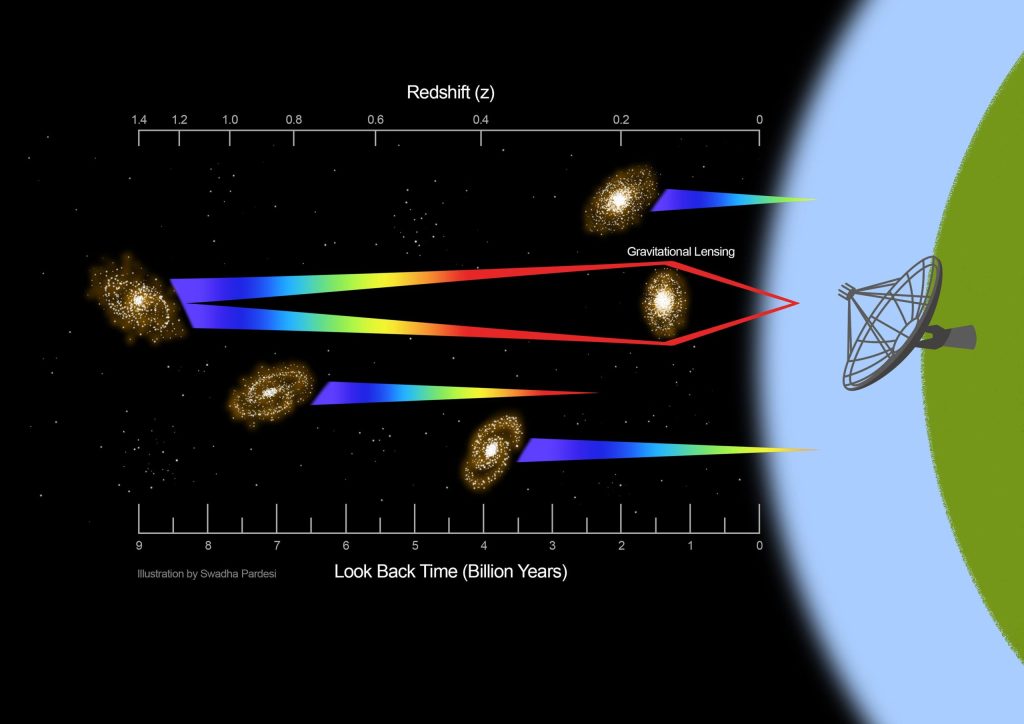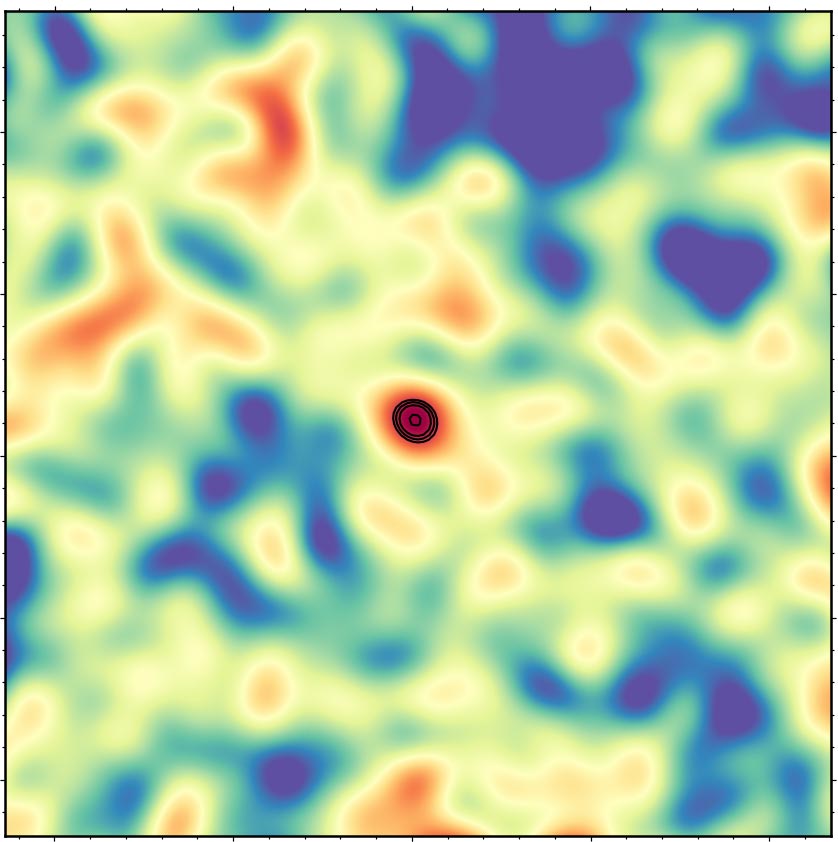Exploration of galaxies at much greater distances from Earth may now be possible.
How do stars form in distant galaxies? Astronomers have been trying to answer this question for a long time by detecting radio signals emitted by nearby galaxies. These signals, however, become weaker the further a galaxy is from Earth, making them difficult to detect with today’s radio telescopes.
Researchers from Montreal and India have now captured a radio signal from the most distant galaxy so far at a specific wavelength known as the 21 cm line, allowing astronomers to peer into the early universe’s secrets. This is the first time a radio signal of this type has been detected at such a large distance using India’s Giant Metrewave Radio Telescope. Illustration showing detection of the signal from a distant galaxy. Credit: Swadha Pardesi
Illustration showing detection of the signal from a distant galaxy. Credit: Swadha Pardesi
“A galaxy emits different kinds of radio signals. Until now, it’s only been possible to capture this particular signal from a galaxy nearby, limiting our knowledge to those galaxies closer to Earth,” says Arnab Chakraborty, a Post-Doctoral Researcher at McGill University under the supervision of Professor Matt Dobbs.
“But thanks to the help of a naturally occurring phenomenon called gravitational lensing, we can capture a faint signal from a record-breaking distance. This will help us understand the composition of galaxies at much greater distances from Earth,” he adds.
A look back in time to the early universe
For the first time, the researchers were able to detect and measure the signal from SDSSJ0826+5630, a distant star-forming galaxy. The atomic mass of the gas content of this particular galaxy, according to the researchers, is nearly twice the mass of the visible stars. Image of the radio signal from the galaxy. Credit: Chakraborty & Roy/NCRA-TIFR/GMRT
Image of the radio signal from the galaxy. Credit: Chakraborty & Roy/NCRA-TIFR/GMRT
The team’s detected signal was emitted from this galaxy when the universe was only 4.9 billion years old, allowing the researchers to peer into the early universe’s secrets. “It’s the equivalent of 8.8 billion years in time,” says Chakraborty, a cosmologist at McGill’s Department of Physics.
Picking up the signal from a distant galaxy
“Gravitational lensing magnifies the signal coming from a distant object to help us peer into the early universe. In this specific case, the signal is bent by the presence of another massive body, another galaxy, between the target and the observer. This effectively results in the magnification of the signal by a factor of 30, allowing the telescope to pick it up,” says co-author Nirupam Roy, an Associate Professor in the Department of Physics at the Indian Institute of Science.
According to the researchers, these observations demonstrate the feasibility of using gravitational lensing to observe distant galaxies in similar situations. It also opens up exciting new possibilities for studying the cosmic evolution of stars and galaxies using existing low-frequency radio telescopes.
Reference: “Detection of H I 21 cm emission from a strongly lensed galaxy at z ∼ 1.3” by Arnab Chakraborty and Nirupam Roy, 23 December 2022, Monthly Notices of the Royal Astronomical Society.
DOI: 10.1093/mnras/stac3696
How do stars form in distant galaxies? Astronomers have been trying to answer this question for a long time by detecting radio signals emitted by nearby galaxies. These signals, however, become weaker the further a galaxy is from Earth, making them difficult to detect with today’s radio telescopes.
Researchers from Montreal and India have now captured a radio signal from the most distant galaxy so far at a specific wavelength known as the 21 cm line, allowing astronomers to peer into the early universe’s secrets. This is the first time a radio signal of this type has been detected at such a large distance using India’s Giant Metrewave Radio Telescope.
 Illustration showing detection of the signal from a distant galaxy. Credit: Swadha Pardesi
Illustration showing detection of the signal from a distant galaxy. Credit: Swadha Pardesi“A galaxy emits different kinds of radio signals. Until now, it’s only been possible to capture this particular signal from a galaxy nearby, limiting our knowledge to those galaxies closer to Earth,” says Arnab Chakraborty, a Post-Doctoral Researcher at McGill University under the supervision of Professor Matt Dobbs.
“But thanks to the help of a naturally occurring phenomenon called gravitational lensing, we can capture a faint signal from a record-breaking distance. This will help us understand the composition of galaxies at much greater distances from Earth,” he adds.
A look back in time to the early universe
For the first time, the researchers were able to detect and measure the signal from SDSSJ0826+5630, a distant star-forming galaxy. The atomic mass of the gas content of this particular galaxy, according to the researchers, is nearly twice the mass of the visible stars.
 Image of the radio signal from the galaxy. Credit: Chakraborty & Roy/NCRA-TIFR/GMRT
Image of the radio signal from the galaxy. Credit: Chakraborty & Roy/NCRA-TIFR/GMRTThe team’s detected signal was emitted from this galaxy when the universe was only 4.9 billion years old, allowing the researchers to peer into the early universe’s secrets. “It’s the equivalent of 8.8 billion years in time,” says Chakraborty, a cosmologist at McGill’s Department of Physics.
Picking up the signal from a distant galaxy
“Gravitational lensing magnifies the signal coming from a distant object to help us peer into the early universe. In this specific case, the signal is bent by the presence of another massive body, another galaxy, between the target and the observer. This effectively results in the magnification of the signal by a factor of 30, allowing the telescope to pick it up,” says co-author Nirupam Roy, an Associate Professor in the Department of Physics at the Indian Institute of Science.
According to the researchers, these observations demonstrate the feasibility of using gravitational lensing to observe distant galaxies in similar situations. It also opens up exciting new possibilities for studying the cosmic evolution of stars and galaxies using existing low-frequency radio telescopes.
Reference: “Detection of H I 21 cm emission from a strongly lensed galaxy at z ∼ 1.3” by Arnab Chakraborty and Nirupam Roy, 23 December 2022, Monthly Notices of the Royal Astronomical Society.
DOI: 10.1093/mnras/stac3696


Post a Comment